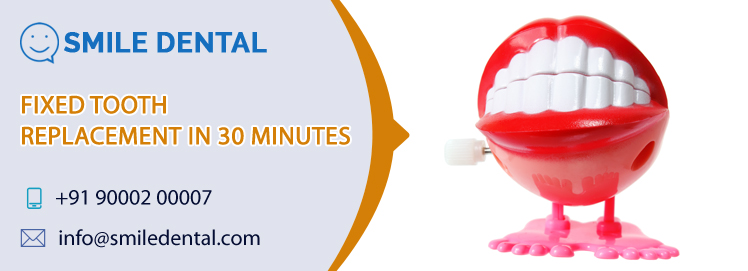Fixed tooth replacement in 30 minutes

Increasing numbers of patients are expressing concern regarding tooth reduction during bridge cutting, happening due to awareness about dental implants. However, fear of surgical procedures and more importantly the high cost of dental implants is still a deterrent to implant procedure. In such situation, we can give the patient an option of fibre supported bridge using everstick crown and bridge.
Stiktech, Finland introduced to us advanced fibre technology with everstick.
Everstick is a product of patented technology, where we have individually silaned E-glass fibres. This fusion of fibre and resin forms an exceptionally strong, aesthetic, and user friendly interpenetrating polymer network.
Unlike, polyethylene fibres (currently in use), everstick is resin interpreted and so bonds to the g-aenial flow [flowable composite]. This bond is much stronger than just a physical bond. You can also cut Everstick with regular scissors as it does not require any special pliers. We can manipulate Everstick as per operator requirement, because of superior handling properties.
The flexural strength is 1280 MPa, i.e. similar to cast chrome cobalt and elastic modulus is similar to that of dentine. This feature is particularly beneficial in Everstick Perio, as the supporting tissue will load more naturally.
Everstick crown & bridge has 4000 fibres placed parallel with a diameter of 1.5 mm.
Steps:
1) Check abutments, occlusion & periodontal health. If case selection is positive, decide whether to make retention groove or not. For groove preparation , make 2 mm deep grooves, 3-5 mm in length in the position where fibres will rest on the teeth. In posteriors, make 4 mm deep proximal grooves. These grooves should not extend onto the occlusal table more than 3-4 mm.
2) Isolate
3) To achieve 12.9µ controlled etching, etch with Ultra etch [Ultradent] . This prevents air entrapment that causes pain & sensitivity.
4) Flowable Gaenial Universal flow [GC] 69% filled material is injectable & is equivalent to a full strength composite, thereby ensuring longevity. Do not cure G-aenial flow; curing is after placement of fibre.
5) For placement of fibre cut the designed length of fibre from the silicon casing with regular scissors, carry with tweezers to the area of operation & position with the help of Stick Stepper behind the fibre with the same instrument, so that the fibre passes through the centre of the tooth to be constructed. In posteriors, place two fibres from abutment to abutment where first fibre is pressing towards the ridge and second is going straight.
When using as a space maintainer, both fibres are straight and parallel to each other. Also, construction of pontic is not necessary.
After fibre positioning is complete, use VALO to light cure 9230 secs.
6) Placement of vertical / transverse fibres: after curing of primary fibre, place additional fibres are for further reinforcement of bridge. In anteriors, place a vertical fibre is running along the length of pontic to be constructed- place the fibre short of gingival and incisal margin. Place it in contact with primary fibre with the help of g-aenial flo. In posteriors, place two or three transverse fibres in bucco-lingual orientation.
7) Cover all fibres with g-aenial flo & cure.
8) Prepare the pontic with three layers of G-aenial composite [76% filled from GC]
– Opaque for fibre masking.
– Dentin shade to build tooth structure.
– Enamel shade to add value [age based] & thereby give unmatched aesthetics.
9) Check for high points/ interferences & treat appropriately.
10) Polish
11) Apply composite sealer [G-coat from GC].
Fibre supported bridge is ready.
Other applications of everstick fibres-
1) Periodontal splinting of mobile teeth.
2) Fixed retention after orthodontic treatment.
3) Flexible fibre post after endodontic treatment.
4) Stabilization of trauma affected teeth.


